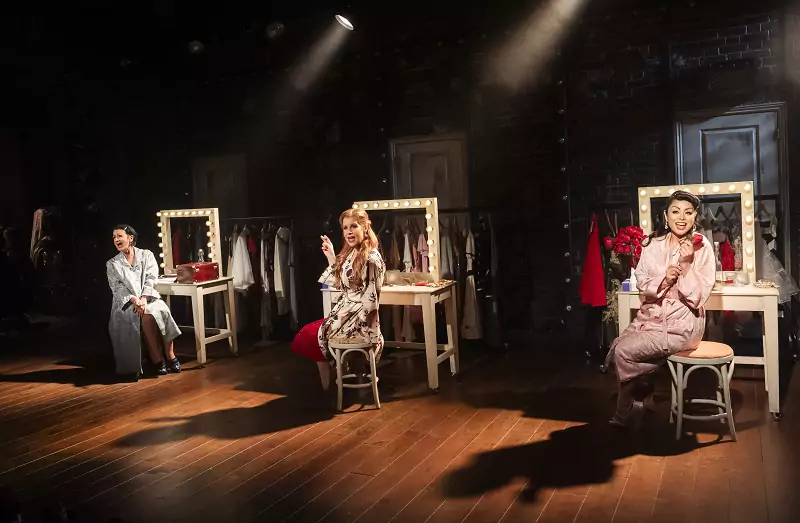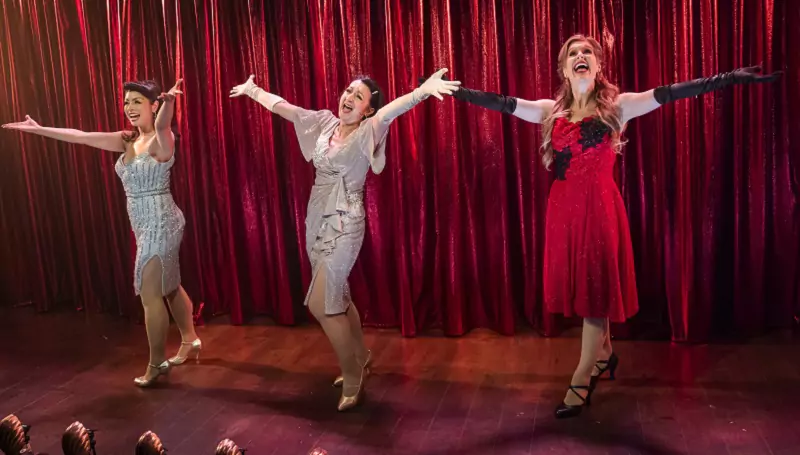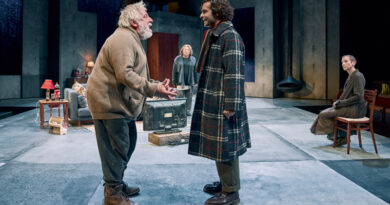Jerry’s Girls at Menier Chocolate Factory
Simon Jenner in south-east London
25 May 2024
In some ways composer/lyricist Jerry Herman (1931–2019) was a pioneer; and for his generation a particularly courageous one. His perennial hit show La Cage aux Folles defiantly dates from 1984 at the start of the AIDS pandemic. Its torch song “I Am What I Am” opens and closes Jerry’s Girls, which is playing at the Menier Chocolate Factory until 29 June, directed by Hannah Chissick. Here though it’s sung by three exceptional actor-singers on stage throughout: Cassidy Janson, Jessica Martin, and Julie Yammanee. So it’s a filtered homage: the bite of the original storyline is lost.

Cassidy Janson, Jessica Martin and Julie Yammanee.
Photo credit: Tristram Kenton.
This is inevitable, given the concept by Herman himself, Larry Alford, and Wayne Cilento, with the show premiering in 1985 and proving valedictory. After it, Herman produced no new musicals. Here, 32 Herman songs are taken from nine of his shows and arranged in an extensive medley. There seems no no attempt at thematic coherence, but given the upbeat sensibility of Herman’s music it hardly matters. You enjoy the lyric moment, the fleeting truth given by the performers.
What we can enjoy is concentrated Herman, and though his melodies are uneven they’re all attractive, and at their best indelibly memorable. They’re listed by show but not running order and the concept allows the singers to give a light touch to the through-line of three actors preparing for a show, in the smoky Menier interior, aided by Philip Gladwell’s atmospheric lighting. Paul Farnsworth’s set consists of three mobile make-up cabinets in lights with a hollow for mirrors, costume rails, three doors the singers disappear through, and very few props.
It allows the singers to brush delicious touches along the thin connecting material tracing the concept together. Set backstage in a Broadway theatre, Janson clamping a cigarette in the corner of her mouth like Reynaldo Hahn, the light conceit of preparing to go on and off is neatly encapsulated by live band music echoed in the same pre-recorded music piped through afterwards, in Mike Walker’s double-take of a sound design.
With the aid of Matt Cole’s tight choreography for the Menier’s small stage, Farnsworth’s props, and many costumes, the trio push a few light jokes. At one point Yammanee is bundled into a laundry basket. In another, Martin is made the willing butt of the other two as they romp their way collectively through “Hello, Dolly!”.
It is what the singers – and band – find in those songs that makes the evening so engaging. Collectively, alone, or occasionally duetting we’re drawn into the aura of a haunting number. Their voices blend beautifully, vibrato is kept to dramatic points, and their vocal sheen proves hypnotic.
Janson with her soaring lyric soprano grasps the soul of such romantic numbers as “Time Heals Everything” (Mack & Mabel, 1974) with its final kick of “but you”; “Kiss Her Now” (from Dear World, 1969); and “Mame” from the eponymous 1966 hit. Janson sustained a foot injury, but her deportment – and sheer determination – ensures it is barely visible. Martin’s dramatic and deeper soprano owns a particular pathos in such standards from Mame as “If He Walked into My Life” and “That’s How Young I Feel”; and “Just Leave Everything to Me” from Hello, Dolly!, Herman’s Tony-sweeping hit of 1964 whose title song even knocked off three Beatles number ones in the US. Yammanee’s coloratura range is also stratospheric; she often leads the other two in such numbers as “Tap Your Troubles Away” from Mack & Mabel involving three typewriters and some percussive wit from the band.
There are some curios too. Jerry’s Girls itself added two new numbers. The trio “Take It All Off”, a striptease number, hardly wears well as concept, even for 1985. The closing song “Jerry’s Girls” though, which touchingly enumerates all the great singers – including, wittily for 1985, Danny La Rue – really does draw an elegant finale to a major career of over 20 years, and a 50-year stint on and off Broadway.
The singers are sovereign and in this intimate space make an unforgettable impression. But the all-women band is stunning too, with musical director and orchestrator Sarah Travis leading on piano (alternating with Wendy Gadian). Around the piano there’s a memorable sonic nimbus: Walker’s sound design again. Travis plays haunting chromatic melodies working against the major-key elements of Herman’s vocal lines. It’s striking and intimate, the piano’s ping moving to sharper, more desolate territory.
Becky Waite’s trumpet is woozily brazen in some numbers and blazing elsewhere. Though what always cuts through in this intimate acoustic (they’re all located stage-right) is Hsaio Ling Huang’s plangent cello, Amy Baldwin’s bass, and Hannah Morgan on a selection of reeds. She rises to klezmer cadenzas on the original material on clarinet, and some oboe moments thrubbing through with Baldwin’s bass elsewhere. Calie Hough’s drums are used for far more than Broadway pizzazz, with drum-taps wittily mimicking those typewriter keyboards and elsewhere where tap-dancing’s to the fore. Travis’s beautiful orchestration deserves plaudits, along with her playing.
This is Herman’s own ideal introduction to his shows, allowing us to place his best melodies, recognizing his limitations. Stephen Sondheim was a year older. Herman is more conventional, but didn’t write an endless number of great standards. But he wrote enough of these, and in La Cage aux Folles he broke new thematic ground. With four numbers from that show profiled here, he must have felt he’d done enough, in one final show proving both radical and courageous. Perhaps he quit while he was ahead, but what a way to sign off. Highly recommended for anyone who loves Broadway musicals.









